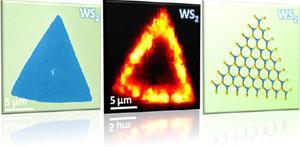
The picture on the right shows what happens when Terrones' team made these small crystals – the edges showed an incredible photoluminescence at room temperature (around 25 times stronger than at the centre of the triangle). As the material changes from bulk to monolayer, the interaction between electronic states also changes and the material becomes a direct band gap semiconductor – allowing electrons that move from a higher energy band to a lower band to emit a photon. However, that doesn't in itself explain the boosted luminescence at the edges. That is helped, it seems, by the structure at the edges, involving zig-zag patterns of sulfur atoms, but the overall explanation is still unclear.






No comments yet